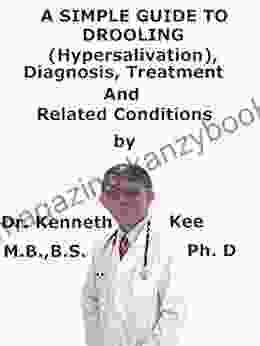Simple Guide to Drooling (Hypersalivation): Diagnosis, Treatment, and Related Conditions

Drooling, also known as hypersalivation, is an excessive production of saliva that can lead to social embarrassment, hygiene issues, and even pain. This comprehensive guide will delve into the causes, diagnosis, treatment options, and related conditions associated with drooling.
Causes of Drooling
Hypersalivation can be caused by a wide range of factors, including:
5 out of 5
| Language | : | English |
| File size | : | 410 KB |
| Text-to-Speech | : | Enabled |
| Screen Reader | : | Supported |
| Enhanced typesetting | : | Enabled |
| Word Wise | : | Enabled |
| Print length | : | 108 pages |
| Lending | : | Enabled |
- Dental problems: Teething, cavities, gum disease, and other dental issues can stimulate excessive saliva production.
- Gastrointestinal disFree Downloads: Gastroesophageal reflux disease (GERD),peptic ulcer disease, and esophageal cancer can cause saliva buildup in the mouth.
- Neurological disFree Downloads: Parkinson's disease, stroke, and cerebral palsy can impair the muscles and nerves responsible for controlling saliva production.
- Medications: Certain medications, such as chemotherapy drugs, antidepressants, and antipsychotics, can trigger drooling as a side effect.
- Other conditions: Infections, sialorrhea, and dehydration can also contribute to hypersalivation.
Diagnosing Drooling
Diagnosing drooling typically involves a physical examination and a medical history review. Your doctor will ask about your symptoms, examine your mouth and throat, and inquire about any underlying conditions or medications you are taking. In some cases, additional tests may be Free Downloaded, such as:
- Saliva flow rate test: Measures the amount of saliva produced over a period of time.
- Endoscopy: A thin, flexible tube inserted into the esophagus to examine for underlying disFree Downloads.
- Electromyography (EMG): Records electrical activity in the muscles and nerves involved in saliva production.
Treatment Options for Drooling
Treatment for drooling depends on the underlying cause. Common treatment options include:
- Dental treatment: Addressing dental problems, such as cavities and gum disease, can help reduce hypersalivation.
- Medications: Anticholinergic drugs, such as scopolamine and glycopyrrolate, can block saliva production.
- Neuromuscular exercises: Exercises designed to strengthen the muscles involved in saliva control can help improve drooling.
- Botox injections: Injections of botulinum toxin can temporarily paralyze the salivary glands, reducing saliva production.
- Surgery: In severe cases, surgery to remove or partially block the salivary glands may be considered.
Related Conditions Associated with Drooling
Drooling can sometimes be a symptom of other underlying conditions, such as:
- Disability: Intellectual disabilities, developmental delays, and physical disabilities can impair the ability to control saliva.
- Sleep apnea: Obstructive sleep apnea can cause excessive saliva production at night.
- Sialorrhea: A condition characterized by chronic excessive saliva production, often caused by underlying neurological disFree Downloads.
- Rabies: In rare cases, drooling can be a symptom of rabies, a deadly viral infection.
Seeking Professional Help for Drooling
If you or someone you know is experiencing persistent drooling, it is important to seek professional evaluation. Excessive saliva production can have significant impacts on quality of life and may indicate an underlying condition that requires treatment. Consult your doctor for proper diagnosis, treatment options, and guidance.
Remember, you are not alone in dealing with drooling. With the right treatment and support, you can manage this condition and improve your overall well-being.
5 out of 5
| Language | : | English |
| File size | : | 410 KB |
| Text-to-Speech | : | Enabled |
| Screen Reader | : | Supported |
| Enhanced typesetting | : | Enabled |
| Word Wise | : | Enabled |
| Print length | : | 108 pages |
| Lending | : | Enabled |
Do you want to contribute by writing guest posts on this blog?
Please contact us and send us a resume of previous articles that you have written.
 Book
Book Novel
Novel Page
Page Chapter
Chapter Text
Text Story
Story Genre
Genre Reader
Reader Library
Library Paperback
Paperback E-book
E-book Magazine
Magazine Newspaper
Newspaper Paragraph
Paragraph Sentence
Sentence Bookmark
Bookmark Shelf
Shelf Glossary
Glossary Bibliography
Bibliography Foreword
Foreword Preface
Preface Synopsis
Synopsis Annotation
Annotation Footnote
Footnote Manuscript
Manuscript Scroll
Scroll Codex
Codex Tome
Tome Bestseller
Bestseller Classics
Classics Library card
Library card Narrative
Narrative Biography
Biography Autobiography
Autobiography Memoir
Memoir Reference
Reference Encyclopedia
Encyclopedia Matthias Nagelschmidt
Matthias Nagelschmidt Theodore E Keats
Theodore E Keats Kim Campbell
Kim Campbell Pamela Mccoll
Pamela Mccoll Kim Tisor
Kim Tisor Maria Ross
Maria Ross Simon Bedford
Simon Bedford Lee Tang
Lee Tang Kim Leatherdale
Kim Leatherdale Meiso
Meiso Violetta Polovinko
Violetta Polovinko Monika Muranyi
Monika Muranyi Lorenzo Maria Dell Uva
Lorenzo Maria Dell Uva Krystle Phillips
Krystle Phillips S J Marshall
S J Marshall Kim Weaver
Kim Weaver Roxanne Black
Roxanne Black Sandra Stupning
Sandra Stupning Waylynn Lucas
Waylynn Lucas Kitty Martone
Kitty Martone
Light bulbAdvertise smarter! Our strategic ad space ensures maximum exposure. Reserve your spot today!

 Joel MitchellHow to Get Great Sound From Any Studio, No Matter How Weird or Cheap Your...
Joel MitchellHow to Get Great Sound From Any Studio, No Matter How Weird or Cheap Your... Trevor BellFollow ·8k
Trevor BellFollow ·8k Thomas PowellFollow ·17.1k
Thomas PowellFollow ·17.1k Jared PowellFollow ·10.7k
Jared PowellFollow ·10.7k Davion PowellFollow ·5.4k
Davion PowellFollow ·5.4k Wesley ReedFollow ·10.2k
Wesley ReedFollow ·10.2k Roald DahlFollow ·5k
Roald DahlFollow ·5k Forrest ReedFollow ·14.6k
Forrest ReedFollow ·14.6k Ian PowellFollow ·3.9k
Ian PowellFollow ·3.9k

 Ernesto Sabato
Ernesto SabatoLoving Table: Creating Memorable Gatherings
Gatherings...

 Mark Twain
Mark TwainLifestyle After Cancer: The Facts
Cancer is a life-changing...

 Keith Cox
Keith CoxUnlocking the Nutritional Needs of Individuals with...
Individuals with physical disabilities...

 Rubén Darío
Rubén DaríoHandbook And Guide To Evaluation And Treatment
Empowering Healthcare...

 Andy Hayes
Andy HayesUnveiling the Truth: "Garden Myths" by Robert Pavlis...
The world of gardening is often filled with a...
5 out of 5
| Language | : | English |
| File size | : | 410 KB |
| Text-to-Speech | : | Enabled |
| Screen Reader | : | Supported |
| Enhanced typesetting | : | Enabled |
| Word Wise | : | Enabled |
| Print length | : | 108 pages |
| Lending | : | Enabled |











